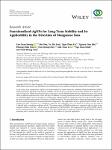Browsing by Author Tran, Quang Huy
Showing results [1 - 8] / 8
In this work, Ag@ZnO and Ag@ZnO/MgAC photocatalysts were synthesized using a simple two-step electrochemical method by the addition of magnesium aminoclay (MgAC) as a great stabilizer and a Lewis base, which could donate electrons for reduction of Ag+ and Zn2+ ions, facilitating uniform formation as well as effective inhibition of aggregation of Ag@ZnO nanoparticles (NPs) on the MgAC matrix. Ag@ZnO and Ag@ZnO/MgAC were investigated for photocatalytic degradation of MB and their antibacterial efficiencies. Ag@ZnO/MgAC showed excellent photocatalytic MB degradation with a performance of 98.56% after 80 min of visible-light irradiation and good antibacterial activity against Salmonella (... |
Conventional Distorted Born Iterative Method (DBIM) using single frequency has low resolution and is prone to creating images with high-contrast subjects. We propose a productive frequency combination method to better result in tomographic ultrasound imaging based on the multi-frequency technique. This study uses the natural mechanism of emitting oscillators' frequencies and uses these frequencies for imaging in iterations. We use a fundamental tone (i.e., the starting frequency f0) for the first iteration in DBIM, then consecutively use its overtones for the next ones. The digital simulation scenarios are tested with other multi-frequency approaches to prove our method's feasibility.... |
In this study, silver nanoparticles (AgNPs) were functionalized by various molecules, including sodium borohydride (NaBH4), polyhexamethylene biguanide hydrochloride (PHMB), and Tween 80 to investigate the long-term stabilization of AgNPs in an aqueous dispersion. PHMB-functionalized silver nanoparticles (AgNPs/PHMB) exhibited better stability than others and could be stored at ambient temperature for at least 180 days. In addition to creating stabilization based on the electrostatic repulsion, the use of PHMB helped to increase the degree of stability of the colloidal AgNPs for a long time owing to strong interactions between Ag atoms on AgNPs with nitrogen (N) positions in PHMB mole... |
Modern society has been facing serious health-related problems including food safety, diseases and illness. Hence, it is urgent to develop analysis methods for the detection and control of food contaminants, disease biomarkers and pathogens. As the traditional instrumental methods have several disadvantages, including being time consuming, and having high cost and laborious procedures, optical nanosensors have emerged as promising alternative or complementary approaches to those traditional ones. With the advantages of simple preparation, high surface-to-volume ratio, excellent biocompatibility, and especially, unique optical properties, gold nanoparticles (AuNPs) have been demonstrat... |
We here invent an implicitly new optical device - cylindrical Fresnel lenses historically used in the decades-old lighthouse concentrator to find application in the field of concentrator photovoltaic, with numerous demonstrations of exotic features in optics. The precious attribute of such a solar concentrator is its ability to grant a focal point sequence, essentially distributed over an arc at any light incidence. The other striking merit of this design is its high acceptance angle, about 60°, at hand and even up to 90°, ideally. We have applied this approach to a simplified principle-of-concept model that closely depicts the octagonal cylindrical Fresnel lens in essence. This conve... |
In ultrasound tomography (UT), Born iterative method (BIM) and distorted-Born iterative method (DBIM) based on Born approximation are considered efficacious. DBIM offers faster convergence compared to BIM; however, it is more susceptible to noise and vice versa. Combined or multi-model imaging is an indispensable trend of modern imaging to detect and accurately assess tissue states. The proposed method exploits the advantages, limiting the disadvantages and increasing the imaging speed of the merging of BIM and DBIM |
In ultrasound tomography (UT), Born iterative method (BIM) and distorted-Born iterative method (DBIM) based on Born approximation are considered efficacious. DBIM offers faster convergence compared to BIM; however, it is more susceptible to noise and vice versa. Combined or multi-model imaging is an indispensable trend of modern imaging to detect and accurately assess tissue states. The proposed method exploits the advantages, limiting the disadvantages and increasing the imaging speed of the merging of BIM and DBIM |
The development of spinel ferrite nanomaterial (SFN)-based hybrid architectures has become more popular owing to the fascinating physicochemical properties of SFNs, such as their good electro-optical and catalytic properties, high chemothermal stability, ease of functionalization, and superparamagnetic behaviour. Furthermore, achieving the perfect combination of SFNs and different nanomaterials has promised to open up many unique synergistic effects and advantages. Inspired by the above-mentioned noteworthy properties, numerous and varied applications have been recently developed, such as energy storage in lithium-ion batteries, environmental pollutant monitoring, and, especially, bio... |



